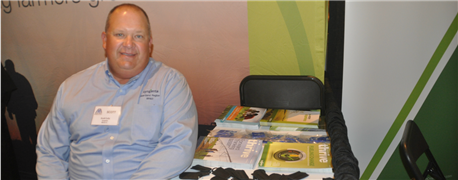
When it comes to plant pests, Syngenta has answers with 16 new products containing three new active ingredients. That's the word that Scott Cully, research and development scientist with Syngenta was sharing at this year's Ag Media Summit in St. Louis.
For corn, the newest products are Acuron and Acuron Flexi, an atrazine-free version of Acuron.
Acuron is a premix of four herbicides from three different groups. The new active ingredient is bicyclopyrone, which adds a new level of control for big-seeded broadleaves as well as grasses.
"It will take care of giant ragweed, morning glory, cocklebur and other broadleaves as well as being very effective on grasses," Cully said.

TALKING CHEMISTRY: Scott Cully, research and development engineer at Syngenta, talked to visitors at this year's Ag Media Summit about new chemistries available to fight weeds and fungal diseases.
The addition of bicyclopryone to the mix allows the use of less of other ingredients including S-metolachlor that are found in Lumax, the predecessor to Acuron, resulting in less active ingredient being introduced into the environment.
Acuron Flexi, a formulation of Acuron but without atrazine in the premix, is recommended for use in watersheds where there is a danger of runoff and where soil types are likely to result in carryover of atrazine.
Application times for Acuron are flexible -- it can be applied from two weeks before planting up to the time the corn ins 12 inches tall. Acuron Flexi can be used on corn up to 30 inches in height.
Syngenta has also introduced two new fungicides, Orondis and Trivapro.
Orondis is now available for vegetables and tobacco. It is a soil-applied fungicide to protect against soil borne diseases such as root rot and phytophthera blights in potatoes and other vegetable crops.
Trivapro is a new fungicide with the active ingredient solatenol and is labeled for corn, soybeans and wheat.
It is effecdtive against Northern Corn Blight, Gray Leaf Spot, Southern Rust and Common Rust and has the advantage of having a longer period of efficacy than previous fungicides.
"This is a product that we are really happy to have in the inventory," Cully said. "We were really hit hard last year by Southern Rust. It was so back that we had stalk issues and lodging."
Cully said the warm, wet growing conditions this year have been ideal for the development of fungal diseases and that Gray Leaf Spot is already a big problem in much of the corn belt and is an increasing threat in the High Plains growing region which has been unusually wet.
"With Trivapro, growers have a fungicide that will last two to three weeks longer than previous products," Cully said. "That can make all the difference in areas where Southern Rust arrives late in the season, but comes on strong."
Syngenta continues to work toward developing herbicides and fungicides with multiple modes of action to help deter resistance of weeds and pathogens to available products.
"Chemistry is a valuable tool, but good management is still essential," he said, "Crop rotation, herbicide and fungicide rotation and resistant varieties are also important.
So far, he said, there is no effective chemistry against the bacterial corn disease, Goss's Wilt, which is beginning to show up in hybrids bred for resistance to the infection.
There are effective antibiotic products against Goss's Wilt, but they are rarely used because of the cost.
"Unless it is really an epidemic and you have no other choice, it is best to not put those products out there," Cully said, "They are really cost prohibitive."
About the Author(s)
You May Also Like






